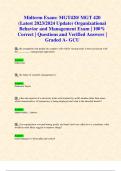Exam (elaborations)
Test Bank Complete_ Vander’s Human Physiology 16th Edition, (2024) By Eric P. Widmaier Dr., Hershel Raff & Kevin T. Strang Dr. All Chapters 1-19| Newest| Correct Questions With Rationale in Every Answers
Test Bank Complete_ Vander’s Human Physiology 16th Edition, (2024) By Eric P. Widmaier Dr., Hershel Raff & Kevin T. Strang Dr. All Chapters 1-19| Newest| Correct Questions With Rationale in Every Answers Table of Contents Chapter 01: Homeostasis: A Framework For Human Physiology 3 Chapter 02: ...
[Show more]













